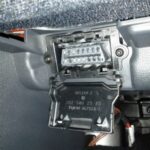The P0420 code is a common trouble code that can trigger the check engine light in your vehicle. It’s often related to the catalytic converter, but as many experienced mechanics know, the diagnostic algorithm for this code can be misleading. Before you jump to replacing expensive parts, especially the catalytic converter, let’s explore what this code really means and how to properly diagnose it.
The P0420 code specifically indicates “Catalyst System Efficiency Below Threshold (Bank 1).” In simpler terms, your car’s computer, the Engine Control Unit (ECU), has detected that the catalytic converter on engine bank 1 is not cleaning exhaust gases as efficiently as it should be. Bank 1 refers to the side of the engine where cylinder number one is located.
Several factors can cause a P0420 code, and it’s not always a faulty catalytic converter. Here are some of the most common culprits:
- Faulty Catalytic Converter: While this is the code’s namesake, it’s not always the primary issue. The catalytic converter’s job is to reduce harmful emissions by converting pollutants in the exhaust gas. Over time, or due to engine problems, it can become less effective.
- Oxygen (O2) Sensor Issues: Your car uses oxygen sensors before and after the catalytic converter to monitor its efficiency. If the downstream O2 sensor (located after the converter) is faulty, it can send incorrect readings to the ECU, triggering a P0420 code even if the catalytic converter is fine. Sometimes, simply swapping the upstream and downstream sensors for Bank 1 can help diagnose if a sensor is the problem.
- Exhaust Leaks: Leaks in the exhaust system, especially before the downstream O2 sensor, can introduce extra oxygen into the exhaust stream. This can skew the O2 sensor readings and lead to a false P0420 code.
- Engine Problems: Issues that cause the engine to run rich (too much fuel) or lean (too little fuel) can overload the catalytic converter and reduce its efficiency. Problems like vacuum leaks, faulty fuel injectors, or issues with the Mass Air Flow (MAF) sensor can indirectly cause a P0420 code.
- O2 Sensor Wiring or Connector Problems: Damaged wiring or loose connectors to the O2 sensors can also cause them to malfunction and trigger the P0420 code.
Diagnosing a P0420 code requires a systematic approach. Here’s a step-by-step process you can follow:
-
Reset the Code and Monitor: The first step is to use an OBD2 scanner to reset the P0420 code. Note the date and mileage when you reset it. Drive your car under normal conditions and see if and when the code returns. Sometimes, a P0420 code can be triggered by a temporary anomaly, and resetting it might resolve the issue, at least temporarily.
-
Check Oxygen Sensors: Consider swapping the upstream and downstream O2 sensors on Bank 1. If the code changes (e.g., to a code indicating a problem with the upstream sensor, or moves to Bank 2 if you swapped sensors across banks), it suggests a faulty O2 sensor. You can also use a multimeter to test the resistance and voltage of the O2 sensors, or use a scan tool to monitor their live data readings.
-
Inspect for Exhaust Leaks: Carefully inspect the exhaust system for any leaks, especially around the catalytic converter and before the downstream O2 sensor. Listen for hissing sounds when the engine is running, and visually check for soot or rust around joints and welds.
-
Check for Engine Performance Issues: Look for other symptoms that might indicate engine problems, such as rough idling, misfires, poor fuel economy, or unusual exhaust smells. Address any underlying engine issues before assuming the catalytic converter is bad.
-
Consider an O2 Sensor Extender: In some cases, especially in older vehicles or those with modifications, the P0420 code can be triggered even when the catalytic converter is functioning adequately. An O2 sensor extender, also known as a spacer, can sometimes resolve this. It moves the downstream O2 sensor slightly out of the direct exhaust stream. This can smooth out the sensor readings and prevent the P0420 code from being triggered. However, be aware that using an extender might mask a real catalytic converter problem and may not be legal in emissions-testing areas. It’s crucial to ensure your vehicle is actually running cleanly, even if the code is suppressed. Remember that a smog test will detect excessive emissions regardless of whether the P0420 code is present.
It’s important to remember that a P0420 code itself doesn’t directly affect how your engine runs. The code is primarily an emissions-related warning. However, ignoring a check engine light and the potential underlying issues can lead to more serious problems down the road. Address the P0420 code to ensure your vehicle is running efficiently and environmentally responsibly, and to avoid potential issues with emissions testing. Always prioritize a thorough diagnosis before replacing expensive components like the catalytic converter.
